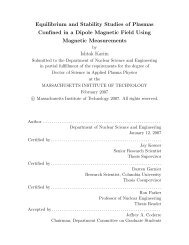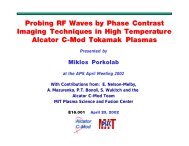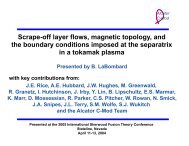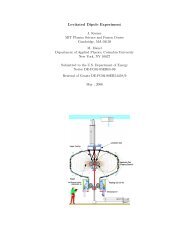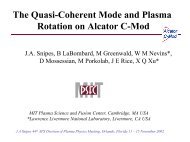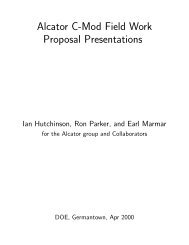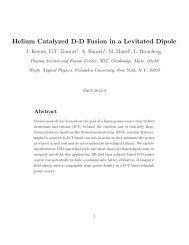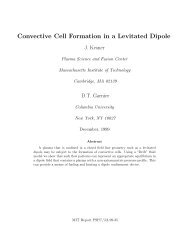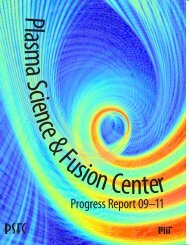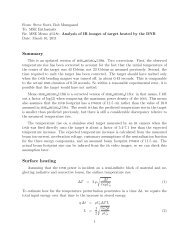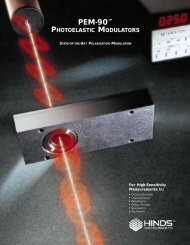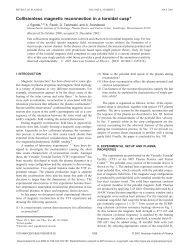From the Director - Plasma Science and Fusion Center - MIT
From the Director - Plasma Science and Fusion Center - MIT
From the Director - Plasma Science and Fusion Center - MIT
Create successful ePaper yourself
Turn your PDF publications into a flip-book with our unique Google optimized e-Paper software.
of <strong>the</strong> floating coil. The figure on page 16<br />
shows <strong>the</strong> magnetic field structure with <strong>the</strong><br />
floating coil levitated. Notice that <strong>the</strong> launching<br />
mechanism has been backed down so<br />
that <strong>the</strong> coil is floating with <strong>the</strong> launcher<br />
entirely outside of <strong>the</strong> plasma. This figure<br />
also indicates <strong>the</strong> heating regions, annotated<br />
by <strong>the</strong> electron cyclotron frequencies,<br />
which are 2.45 <strong>and</strong> 6.4 GHz respectively. As<br />
compared to previous studies in which <strong>the</strong><br />
internal coil was supported, levitation results<br />
in improved particle confinement, which<br />
allows high-density, high-beta discharges to<br />
be maintained at significantly reduced gas<br />
fueling. Elimination of parallel losses coupled<br />
with reduced gas fueling was observed to lead<br />
to improved energy confinement. Improved<br />
particle confinement assures stability of <strong>the</strong><br />
hot electron component at reduced pressure,<br />
<strong>and</strong> this self-consistency produces significantly<br />
improved dipole discharges. A video of <strong>the</strong> first<br />
levitated plasma operation may be viewed on<br />
<strong>the</strong> LDX website (www.psfc.mit.edu/ldx/).<br />
Measured contours of <strong>the</strong> plasma density, current density,<br />
<strong>and</strong> <strong>the</strong> reconnection rate during a spontaneous reconnection<br />
event in VTF. The overlaid lines represent contours of<br />
<strong>the</strong> magnetic flux function, which coincide with <strong>the</strong> poloidal<br />
projection of magnetic field lines. One value of <strong>the</strong> flux function<br />
is highlighted such that <strong>the</strong> motion of <strong>the</strong> field lines can<br />
be followed in time.<br />
Jan Egedal (center) works with graduate students Noam Katz<br />
(left) <strong>and</strong> Will Fox (right) on magnetic reconnection, using VTF.<br />
Magnetic Reconnection Experiments on<br />
<strong>the</strong> Versatile Toroidal Facility (VTF)<br />
Magnetic reconnection plays a fundamental<br />
role in magnetized plasmas as it permits<br />
rapid release of magnetic stress <strong>and</strong> energy<br />
through changes in <strong>the</strong> magnetic field line<br />
topology. It controls <strong>the</strong> spatial <strong>and</strong> temporal<br />
evolution of explosive events such as solar<br />
flares, coronal mass ejections, <strong>and</strong> magnetic<br />
storms in <strong>the</strong> earth’s magnetotail, driving <strong>the</strong><br />
auroral phenomena. Magnetic reconnection<br />
is studied in VTF under <strong>the</strong> leadership of Dr.<br />
Jan Egedal, appointed Assistant Professor of<br />
Physics in 2005. The new magnetic geometry<br />
of VTF is providing insight to what controls<br />
<strong>the</strong> onset of <strong>the</strong> explosive magnetic reconnection<br />
event observed in nature. In January 2007<br />
a Physical Review Letter was published detailing<br />
<strong>the</strong> first observation of a spontaneous reconnection<br />
event in a toroidal geometry (figure,<br />
left). The focus of <strong>the</strong> experiment is now to<br />
explore <strong>the</strong> physics of <strong>the</strong> three-dimensional<br />
mechanism that initiates <strong>the</strong>se events.<br />
Novel Diagnostics for <strong>Fusion</strong> Research<br />
The PSFC is developing two novel diagnostics<br />
for fusion research:<br />
17



